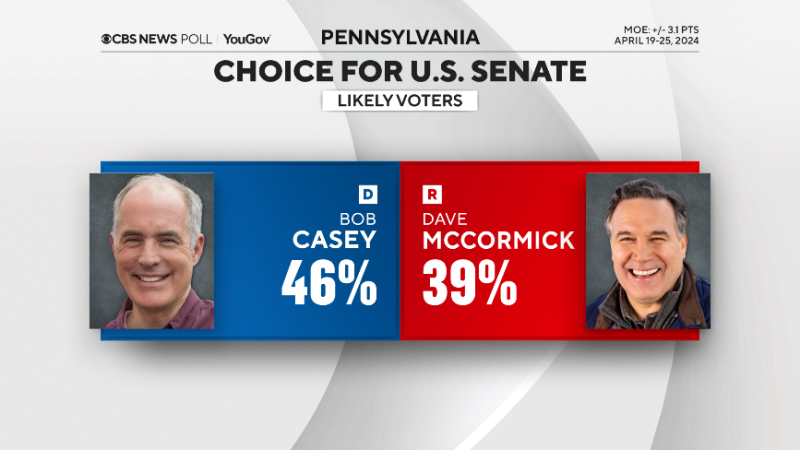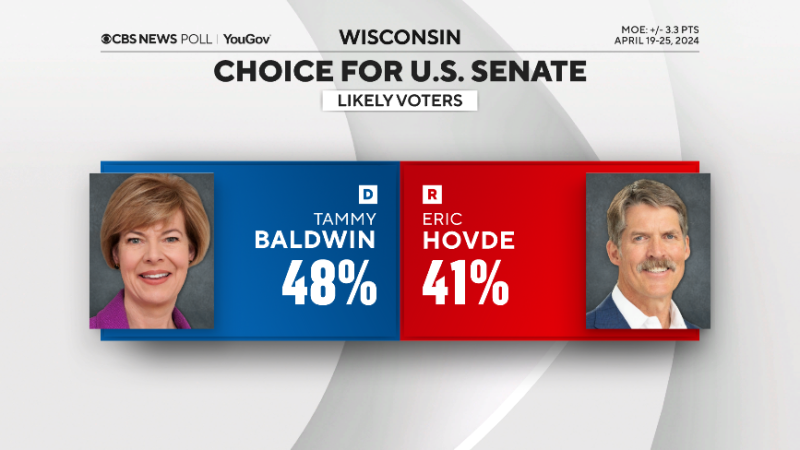Democrats start out ahead in Pennsylvania, Wisconsin 2024 Senate races — CBS News Battleground Tracker poll
As Democrats play defense in U.S. Senate races this year, two battleground-state incumbents start out ahead in their reelection campaigns. Bob Casey in Pennsylvania and Tammy Baldwin in Wisconsin are currently leading their lesser-known Republican challengers by seven points.
Both Casey and Baldwin enjoyed large margins of victory in 2018, but their reelection bids look more competitive at the moment in what is a more challenging environment. We find plenty of undecided voters and good reasons for the races to tighten as the campaigns heat up this fall.


Why things might change
These estimates are snapshots of the race early in the election cycle. With several months to go before voting starts, there is plenty of time for movement.
So here's why things could change: For one, the Republicans in the race are not well-known to voters. It was under a week ago that David McCormick officially became the GOP nominee in Pennsylvania. He also ran for Senate in 2022, but lost to Mehmet Oz in the GOP primary. Eric Hovde in Wisconsin is currently much less familiar to voters than Baldwin, but the primary there isn't until August, giving him plenty of time to get on voters' radars and make his case.
Despite enjoying higher name recognition than their challengers, both Casey and Baldwin are under 50% in the current preferences of likely voters. That leaves some work for them to do to persuade enough undecided voters to get them over the top. And they would be doing so in a different environment than the one six years ago. Back then, widespread anger toward Donald Trump propelled huge turnout and a blue wave. Today, many voters are unhappy with President Biden's job performance, and the presidential race is very competitive in these states right now.
And importantly, when you look at their recent votes for president and Congress, the undecided in these Senate races are by and large Republican voters — not surprising since they may not yet be familiar with their party's nominee. They're mostly voting for Trump at the top of the ticket. So there are lots of voters up for grabs who otherwise lean Republican.
Given the decline in ticket splitting, our baseline expectation should be that these undecided voters will pick GOP candidates down ballot. In fact, only 5% of likely voters in Pennsylvania and 4% in Wisconsin are currently choosing different parties for president and Senate, slightly benefiting the Democratic senators at the moment. If undecided voters were choosing the same party for president and Senate, the margin in both races would tighten to under five points.
These CBS News/YouGov surveys were conducted between April 19-25, 2024. They are based on representative samples of 1,306 registered voters in Pennsylvania and 1,245 in Wisconsin. Margins of error for likely voters are ±3.1 points in Pennsylvania and ±3.3 points in Wisconsin.
Pennysylvania toplines
Wisconsin toplines
- In:
- Pennsylvania
- Bob Casey
- United States Senate
- Opinion Poll
- Wisconsin

Kabir Khanna is Deputy Director, Elections & Data Analytics at CBS News. He conducts surveys, develops statistical models, and projects races at the network Decision Desk. His scholarly research centers on political behavior and methodology. He holds a PhD in political science from Princeton University.
TwitterDisclaimer: The copyright of this article belongs to the original author. Reposting this article is solely for the purpose of information dissemination and does not constitute any investment advice. If there is any infringement, please contact us immediately. We will make corrections or deletions as necessary. Thank you.







